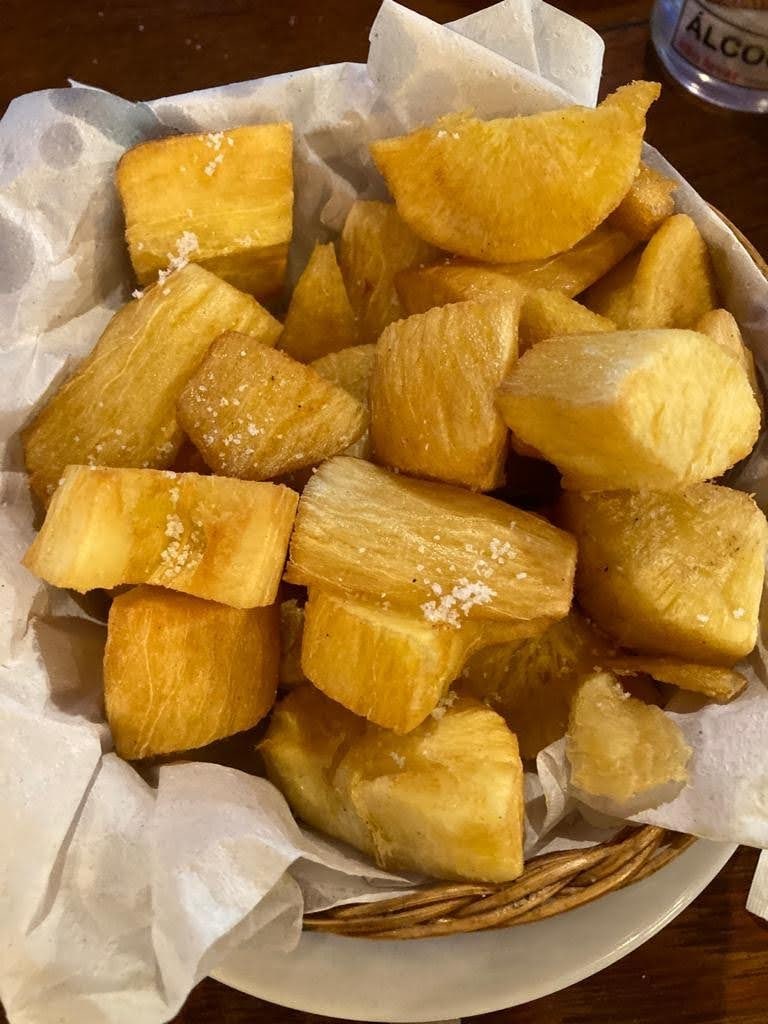Welcome to the summer section of the blog. Exactly in 5 months, we will start again…Now it’s time only for travel memories. On November 7, 2018, on our first day of vacation in Brazil, exactly in Rio de Janeiro, we stopped at one of the many restaurants in Copacabana, precisely at “Boteco cevada” Praça Serzedelo Corrêa, 27, and there we had lunch with typical Brazilian gastronomy dishes. As the first comida brasileira of the vacation, I couldn’t choose anything else: linguiça calabresa and fried aipim. Two “musts” of Brazilian cuisine.
What is linguiça calabresa? It’s nothing more than a relative of our sausage, made with pork and usually cooked in a pan with onion (açebolada indeed). It is also one of the essential ingredients of feijoada, another dish of Brazilian tradition. In Italy, it is unattainable; you can buy it in Brazil or online, or else you can try making it yourself. Here I propose a recipe, but it’s essential to have good meat.
What is aipim? It’s nothing more than the more known manioc (or cassava), also called “macaxeira” or “yuca” depending on which part of Brazil or South America you are in.
It is a tuberous root rich in properties that is the base of many South American cuisines. From grinding manioc, you also get tapioca (manioc starch), present in our diet, mainly in infant formulae, and manioc flour, which in Brazil is used as a side dish, for example, to make farofa, that is, toasting it and mixing it with bacon, onion, garlic, and sometimes even with egg, again depending on which part of Brazil you are eating it.
But today, in this recipe, we will see the simplest and most delicious version of manioc, called aipim in Rio, that is, fried.

- Difficulty: Very easy
- Cost: Economical
- Preparation time: 5 Minutes
- Portions: 4 people
- Cooking methods: Stovetop
- Cuisine: Brazilian
Ingredients
- 4.4 lbs pork meat
- 2.2 lbs lard cut into small pieces
- 1 tbsp salt
- 6 cloves crushed garlic
- 2 tbsps chili pepper (preferably Calabrian)
- 2 tbsps fennel seeds
- 1 tbsp sugar
- 1 casing
- 3 medium onions
- 3 tbsps olive oil
- 3 cloves garlic
- to taste manioc flour
- 2 large manioc
- to taste vegetable oil for frying
- to taste salt
Preparation
Mix the meat well with spices and sugar and let it rest for 6 hours, stirring occasionally. Fill the casing with the meat (following the same procedure used for traditional sausages). Poke a few holes and hang the linguiça in a cool, dry place.
Slice the linguiça calabresa into 0.4-inch slices and place it in a large pan already on the heat, add 100 ml of water, cover, and let it cook on high heat until all the water in the pan has evaporated, allowing the fat to melt and the sausage to cook in its own fat. Turn during cooking. Once the water has reduced, add the chopped onions and stir again until the onions become slightly shiny, add the olive oil, and the garlic. When the garlic is golden but not burned, add manioc flour to your liking, adjust salt. Serve as desired on a lettuce leaf.

Peel the aipim or manioc and cut it into large pieces. Put it in salted water and cook until soft but not falling apart. Drain, cut the pieces lengthwise, remove the central part, and cut the two halves into sticks. Heat oil in a pan and fry them, turning until well browned. Drain, place on absorbent paper, salt, and serve alongside the linguiça calabresa acebolada.

Linguiça Mineira, larger and spicier.

Packaged linguiça calabresa, big and small.

It can be a main course or a snack better enjoyed with a caipirinha!
To make the work easier, you can use a sausage stuffer.

